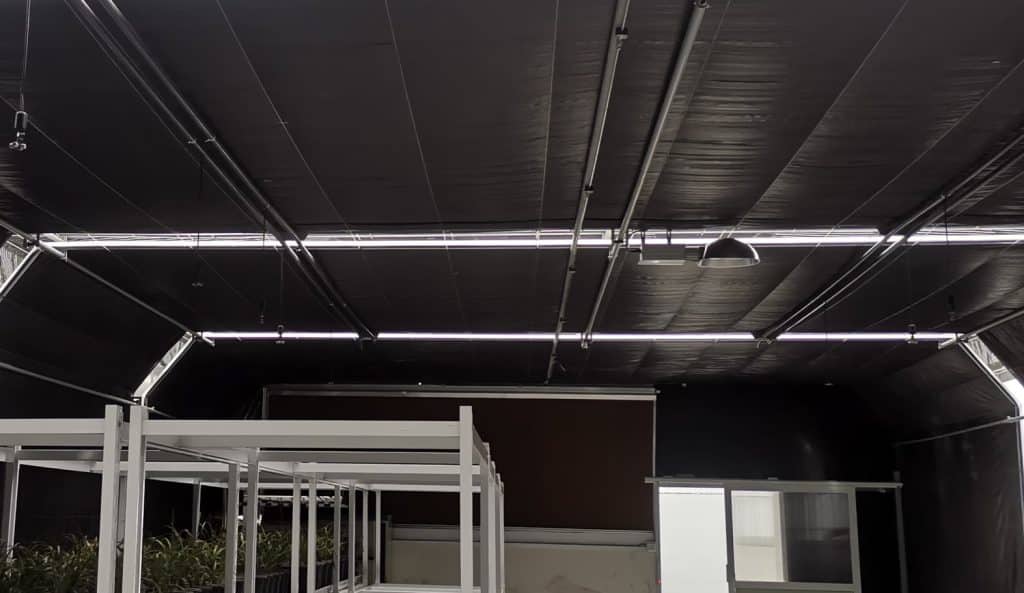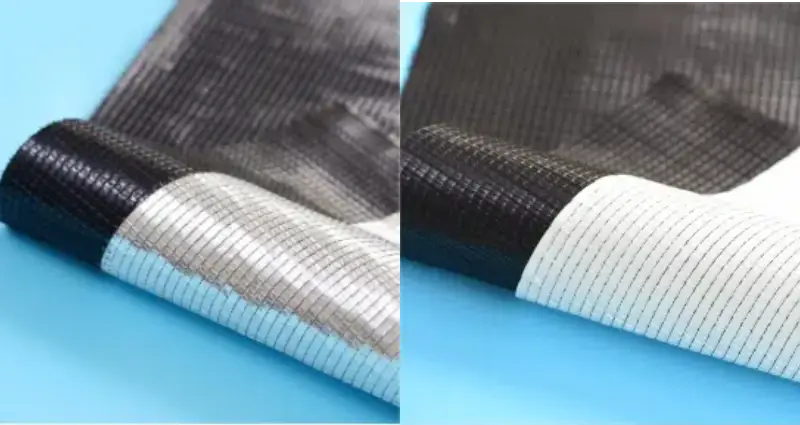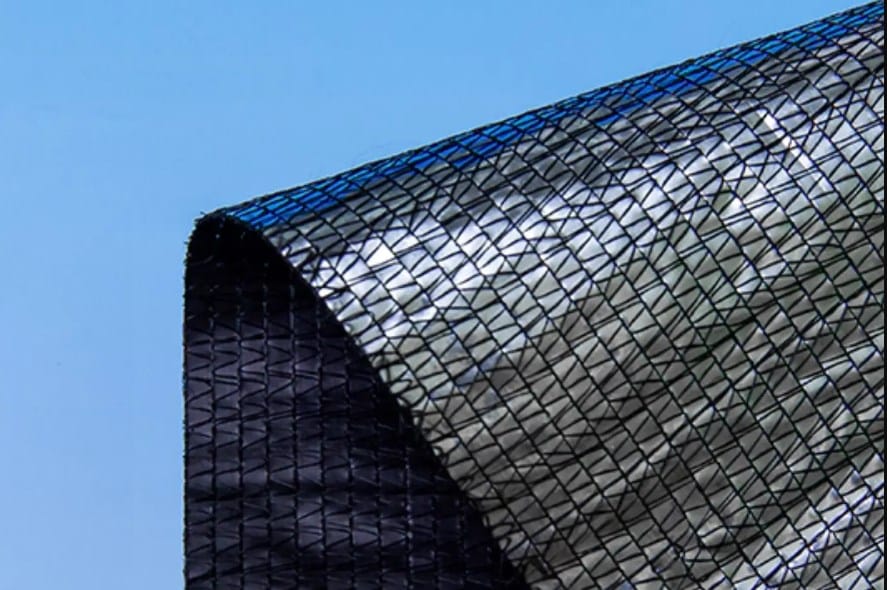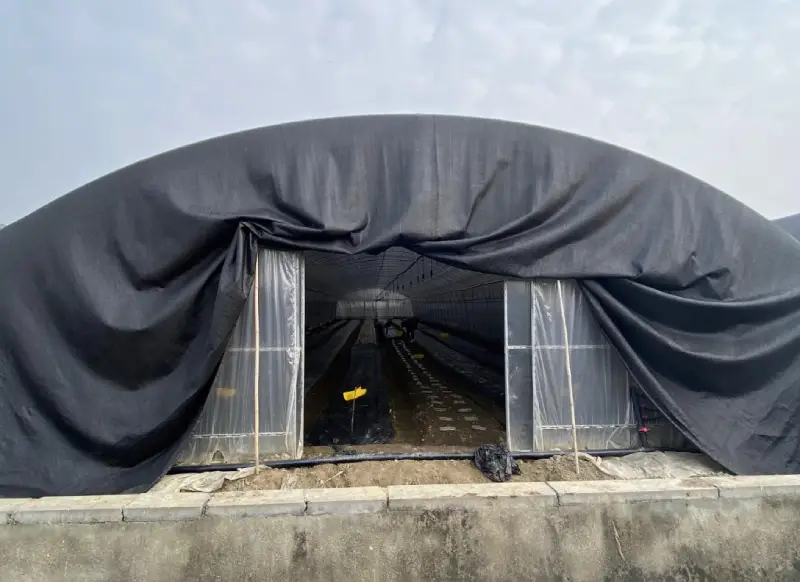In the greenhouse, every ray of sunlight is a precious resource for plant growth, yet sometimes too much light can hinder their development. That’s precisely why greenhouse blackout covers have become indispensable. In this article, we will discuss everything about greenhouse blackout covering, including their functions, types, and installation knowledge. Please continue reading to learn more.
What is a Blackout Cover and What is Its Function?
A greenhouse blackout cover is a specialized material used in greenhouses or plant-growing environments, mainly to block out sunlight and other sources of light to simulate night-time or shorter daylight hours. These covers typically achieve over 99% light blockage and are often used in light-deprivation greenhouses for the following purposes:

Greenhouse Blackout Cover Function
- Precise control of plant growth cycles: By simulating various daylight cycles, they encourage crops to enter their flowering or fruit maturation stages at specific times.
- Increase crop yield and quality: Blackout covers help create the ideal growing environment, increasing crop output and improving quality.
- Save energy and costs: Effective light control can reduce reliance on greenhouse heating and cooling systems, thus lowering energy consumption and related expenses.
- Achieve year-round production: Unrestricted by natural light conditions, they allow for the adjustment of growth cycles throughout the year, facilitating all-season planting and harvesting.
Greenhouse Blackout Cover Types
Full blackout material is designed for plants with strict light cycle requirements, such as cannabis, ensuring a light blockage rate of over 99%, providing a reliable solution for light control. Based on their structure and purpose, they can be categorized into the following types, each with slight differences in cost and application.
1. Single-Layer Blackout Covers
The single-layer covers, like our LRS B series or standard 95% black shading cloth, are suitable for warm climates and focus on blocking light rather than providing insulation. They are more affordable and fit environments where temperature control is not necessary or for personal greenhouse use.

One-layer blackout cloth for greenhouse
2. Double-Layer Blackout Covers
Double-layer blackout screens are more durable than single-layer ones and are commonly used in commercial light-deprivation greenhouses, such as those for growing medicinal plants like cannabis. These covers usually have a black layer for light deprivation, with the other layer made of white, black fabric, or silver aluminum foil for heat control.

Double layers cover for light deprivation greenhouse
For instance, our LRS A/B series not only provides shading but also reflects heat with its aluminum side, offering about 75% energy savings, beneficial for plant growth during the cold season, and also saving substantial energy costs.
3. Flame-Retardant Blackout Covers
Due to the flammability of standard greenhouse covers, flame-retardant blackout cloth is essential in scenarios where safety is paramount, such as when heating greenhouses with stoves in winter or in hot and dry areas during summer.

Rockport commercial greenhouse partially destroyed by fast-moving fire – source
These materials typically undergo testing and meet local fire standards, such as NFPA 701, to fulfill their flame-retardant purpose. Our SCREENMAX brand’s LRS A/B FR and LRS B/B100 FR series not only provide excellent shading and insulation performance but also meet the NFPA 701 flame retardant standards, offering additional safety protection for cultivating high-value crops in your greenhouse.

Flame-Retardant Blackout Cover for Greenhouse – LRS A/B FR
How to Install Blackout Cover for Your Greenhouse?
The installation methods for greenhouse covers are generally similar, but they can vary depending on the size of your greenhouse and your budget. Here we offer some suggestions for installing light deprivation covers in both small and large greenhouses.
1. For Small Greenhouses
For personal and small greenhouses, such as those spanning only a few meters, the installation of blackout cover can be completed manually. Before installation, ensure that the greenhouse structure is sturdy, as some blackout material can be quite heavy and the framework must support their weight.

Manually install blackout cloth for the greenhouse
Once the blackout climate screen is in place, secure the edges with clips or hooks to prevent it from being carried away by strong winds or heavy snow. Additionally, the top of the greenhouse should have a slight incline to allow rainwater and snow to slide off, preventing accumulation. Lastly, the tension of the blackout greenhouse covering should be just right—not too tight to risk tearing, nor too loose to flap in the wind.
2. For Large Greenhouses
For commercial or large-scale greenhouses, to save on labor, the installation of blackout covers usually involves a professional track and pulley system. This ensures that the entire cover can be smoothly opened and closed. Such systems, commonly known as curtain systems, come in electric and manual varieties. An electric control system makes operation more convenient, but if the budget is limited, a manual control system can also work, though it may require more effort.
Regardless of the method chosen, perform several tests after installation and make adjustments as needed to ensure the system functions smoothly, protecting the plants from unexpected light exposure or insufficient shading.
FAQ
1. What is a Light Deprivation Greenhouse?
A Light Deprivation Greenhouse, often referred to as a “dark greenhouse” or “blackout greenhouse,” is a specialized type of greenhouse that allows farmers complete control over the lighting inside. These greenhouses are usually equipped with blackout covers or systems that can artificially simulate night-time or shorter periods of daylight for precise control over plant growth cycles.
The advantages of such greenhouses are evident in several ways:
- Promoting Flowering: Certain plants, like cannabis and some ornamental species, require specific light cycles to initiate flowering. Blackout techniques can accurately control these cycles, inducing flowering even during seasons of prolonged natural daylight.
- Multi-Season Harvesting: Light control enables farmers to harvest crops at any time of the year, not just during traditional growing seasons.
- Increasing Yield and Quality: Managing light cycles can enhance the yield and quality of specific crops, as farmers can create optimal growth conditions.
- Energy Saving: Utilizing blackout methods can reduce the internal temperature of greenhouses during hot seasons, thereby decreasing the use of cooling systems and energy consumption.
Light-deprivation greenhouses are particularly well-suited for light-sensitive crops and are becoming increasingly popular in commercial agriculture, especially for the cultivation of plants that require strict growth control.
Conclusion
The right blackout covering can create a perfect world for your plants, whether in the heat of summer or the cold of winter. Their impact goes beyond merely blocking sunlight; they’re also about energy efficiency, safety, and boosting yields. Now that you’re armed with this knowledge, if you have further questions, feel free to contact us or discuss them in the comments. Additionally, for bulk purchases of blackout cloth rolls, please get in touch with us to receive a competitive quote.
